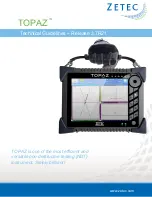
39
Exercise C - Initiation and characteristics of bedload
motion
Theory
Sediment can be transported along a river channel in three ways. Wash load
originates in slope runoff and bank erosion, and is controlled by sediment supply rate
rather than the river’s ability to transport sediment. The dissolved load represents the
portion of sediment that is carried in solution, and derives from rock and soil
weathering. This generally decreases with discharge and normally has no effect on
alluvial channel form. Bed load material is composed of sediment originating in the
channel bed and bank. Bed material load is relatively coarse and moves as bed or
near-bed load and is almost entirely a function of the flow’s ability to transport
material and requires an understanding of how and why material is transported.
Water flow along an open channel is controlled by two opposing forces. The
downstream or driving force results from the downstream component of the weight of
the water, and is therefore governed by gravitational laws. This force may be divided
by the area over which it acts to obtain the bed shear stress. The opposing upstream
force is generated by friction between the water and the sediment of the channel
boundary.
To remain stationary the boundary sediment must supply an equal opposing force to
that associated with the bed shear stress. The opposing force derives from friction
and interlocking between grains. Bed shear stress increases with flow intensity (
O),
at a rate approximately equal to the square of the mean velocity. If the bed shear
force exceeds the opposing friction force then the geomorphological threshold of
motion (
CR) is crossed, and sediment grains start to move along the channel bed.
At flow intensities just above the threshold of motion, sediment particles move by
rolling
and sliding along the bed. As flow intensity increases, grains lift out of the bed
and bounce along the channel following ballistic trajectories. This motion is thought to
be promoted by the effect of fluid lift force, and the particles are said to be
saltating
.
Sediment grains travelling by rolling, sliding or saltating are all in frequent or
continuous contact with the channel bed and are classified as
bedload
. At higher flow
intensities sediment particles are carried in the flow continuously by
suspension
due
to anisotropic turbulence. Suspended bed sediment and the wash load combine to
form the
suspended load
.
The force required to move the boundary sediment is influenced by several factors,
including sediment grain size and sediment position (as particles on the channel
bank are subjected to different levels of force than those on the channel bed). Once a
particle is in motion, less force is required to keep it in transport. The threshold of
motion is highly important as it marks the onset of processes of sediment transport,
erosion and, in turn, deposition. These processes are responsible for morphological
adjustment of the fluvial system and hence the threshold of motion marks the point at
which the flow starts to control the shape of the channel.
Procedure
Connect the flexible piping from the river inlet tank to the quick release connector on
the 5 l/min flow meter.
Set the slope of the sand tank to between 0.6% and 0.8%. Smooth the sand level,
parallel to the top of the tank, and lightly tamp it down. Use the scoop provided to cut
a straight * trapezoidal channel into the sediment bed, from the river inlet tank to the
Summary of Contents for S12-MKII
Page 1: ...Advanced Environmental Hydrology System Instruction Manual S12 MKII ISSUE 21 February 2014...
Page 4: ......
Page 8: ...4 Equipment Diagrams Figure 1 Front View of S12 MKII Hydrology System...
Page 9: ...Equipment Diagrams 5 Figure 2 Plan View of S12 MKII Hydrology System...
Page 10: ...Armfield Instruction Manual 6 Figure 3 End View of S12 MKII Hydrology System...
















































